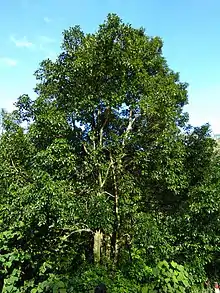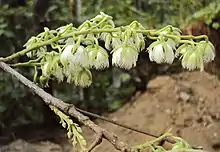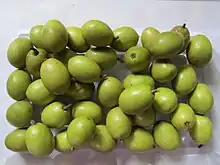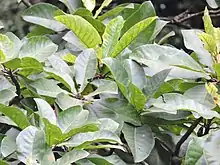Elaeocarpus serratus
Elaeocarpus serratus is a tropical flowering plant in the family Elaeocarpaceae. It is a medium to large tree, with white flowers. It has a disjunctive distribution, with the species occurring in Sri Lanka and southern India, and in Assam, Bangladesh and other parts in the north of the Indian subcontinent. The fruit is commonly eaten, and people also use the plant for ornamental, religious and folk-medicinal purposes. There are historical records of traditional-medicine use of the plant. Paradoxurus jerdoni (Brown palm civet) consumes parts of the tree.
| Elaeocarpus serratus | |
|---|---|
 | |
| Scientific classification | |
| Kingdom: | Plantae |
| Clade: | Tracheophytes |
| Clade: | Angiosperms |
| Clade: | Eudicots |
| Clade: | Rosids |
| Order: | Oxalidales |
| Family: | Elaeocarpaceae |
| Genus: | Elaeocarpus |
| Species: | E. serratus |
| Binomial name | |
| Elaeocarpus serratus | |
| Varieties[1] | |
|
Elaeocarpus serratus var. weibelii Zmarzty | |
| Synonyms[2] | |
| |


_seeds.jpg.webp)

Variety
The species has an accepted variety, Elaeocarpus serratus var. weibelii.[1]
Description
The taxa is a medium to large evergreen tree with a large spreading crown, reaching 15 to 60m in height.[3] The flowers have pale-green petiole, 5 white to pale-olive-green calyxes calyx, sepal 4-6mm long, 5 white corollas, petals 4-5mm long, slightly-black anther, 18-30 stamen.[4] The flowers expand to maximum size in late afternoon and hence are likely adapted to night pollinators, i.e. moths. Bears smooth ovoid green fruits[5] the size of about 2.5 cm long. Recommended varieties are local cultivars (round and oval fruits).[6] It has a brown seed inside the fruit. The seed has a hard outer shell. The seeds are slow for germination and can take up to 2 years. The wood is whitish yellow.
Distribution
The species has a disjunctive distribution, it is native to an area of southern and southwest India and Sri Lanka, and to an area from Assam, northeast India, to Bangladesh.[2] Countries and regions in which it is indigenous to are: Sri Lanka; India (Tamil Nadu, Karnataka, Kerala, Assam, Arunachal Pradesh);[3] Bangladesh. It has been introduced/naturalised to Réunion and Mauritius. It is widely available in the villages of West Bengal also. It is called 'Jalpai' and people eat it raw or make chutney, Jalpai ambal, or make Achar also.
The weibelii variety is native to Karnataka and Kerala in southwest India.[1]
Habitat and ecology
The tree is drought tolerant.[3] Areas of high suitability for the plant in Assam include continuous patches of tropical and subtropical forest, and areas with a mosaic of fragmented groves, settled cultivation areas and human settlements. It grow less well in areas of degraded open forest, settled cultivation, homestead gardens and some human settlements. Areas of low suitability include grasslands, degraded open forest and some human settlements.
It natively occurs in the Sinharaja Forest Reserve, Sri Lanka,[4] and is found in various protected areas of Assam, including Nameri National Park, Dibru-Saikhowa National Park, Pakke Tiger Reserve and Hoollongapar Gibbon Sanctuary.[3]
The palm civet Paradoxurus jerdoni (Brown palm civet) consumes parts of the plant.[7]
The population in India is rapidly decreasing, partly due to over-exploitation of the plant (particularly for seeds), and partly due to habitat destruction.[3] It is cited as vulnerable in Arunachal Pradesh and Assam.
Vernacular names
- veralu (වෙරළු) (Sinhala)[6]
- veralikkai (Tamil)[6]
- kaarakka, kaara (Malayalam)[6]
- belfoi(ꠛꠦꠟꠚꠁ) (Sylheti, Bangladesh)[6]
- jalpai (জলপাই) (Bengali)[6]
- okhi-siming (Karbi language, Assam)[8]
- zolphai (জলফাই) (Assamese)[6]
- chorphon (Meitei language, Manipur)[6]
- rudraksh (India)[3]
- bead tree (India)[3]
- Ceylon-olive (English)[9][6]
Uses
The taxa is used as an ornamental plant and its fruit are eaten.[10]
The fruit of the taxa is well known in Sri Lanka.[6] Pickled Ceylon olives are eaten as popular street food within the country. It is also used as a part of indigenous medical treatments and as a part of local cuisine.
Use of the plant is recorded historically in India, the fruit was believed to ward off evil spirits and omens.[3] In recent folk medicine, various parts of the plant have been used to treat a large variety of ailments.[3]
People living in Mai Municipality, Ilam District, far-eastern Nepal, use the plant as part of folk medicine and in religion. Juice from the bark is drunk in treatment for jaundice, while a paste from the seed is eaten in belief of a treatment for pneumonia and ulcer.[11]
The Karbi people of Karbi Anglong District, Assam, harvest both ripe and unripe fruit from August to October, the ripe fruit is made into a pickle, the taste of the fruit is sour.[8] Both ripe and unripe fruit are also sold in local markets, in the years 2005-2007 they fetched Rs. 20/- to 30/- per kilogram (cheap, but not in the cheapest price range).
The fruits are high in starch and sugar and have low amounts of protein and iron.[6] It may help treat diarrhoea due to its constipating effect.[6].
History
The founder of modern biological nomenclature, the Swede Carl Linnaeus (1707-78) named the species in 1753 in his work Species Plantarum. The weibelii variety was named by the taxonomist Sue Zmarzty (born 1959) in 2001, publishing the description in the Kew Bulletin, 56(2), page 437.

References
- "Elaeocarpus serratus var. weibelii Zmarzty". Plants of the World Online. Royal Botanic Gardens, Kew. Retrieved 11 May 2021.
- "Elaeocarpus serratus L." Plants of the World Online. Royal Botanic Gardens, Kew. Retrieved 11 May 2021.
- Baruah, Prantik Sharma; with five others (2019). "Habitat distributionmodelling and reinforcement of Elaeocarpus serratus L. - A threatened tree species of Assam, India for improvement of its conservation status". Acta Ecologica Sinica. 39: 42–49. doi:10.1016/j.chnaes.2018.06.002. S2CID 89985091. Retrieved 11 May 2021.
- Susanti, Ruliyana; Sripanomyom, Siriya. "Role of Calyx Coloration in the Attraction of Pollinators in Elaeocarpus (Elaeocarpaceae)". In Khoo, Min Sheng; Hong-Wa, Cynthia; Harrison, Rhett D. (eds.). Proceedings of the Center for Tropical Forest Science – Arnold Arboretum International Field Biology Course 2006 (PDF). Center for Tropical Forest Science – Arnold Arboretum Asia Program University of Peradeniya Forest Department Sri Lanka. pp. 89–91. Retrieved 11 May 2021.
- M.F. Macmillan (1989). Handbook of Tropical Plants. p. 560.
- Department of Agriculture, Peradeniya, Sri Lanka, Task Force on Fruits & Fruit Development Board (1997). Tropical Fruits of Sri Lanka. Ministry of Agriculture and Lands, Sri Lanka. p. 29.
{{cite book}}: CS1 maint: multiple names: authors list (link) - "Elaeocarpus serratus L." Encyclopedia of Life. eol.org. Retrieved 11 May 2021.
- Kar, A.; Borkataki, S.; Borthakur, S. K. (2008). "Wild edible fruits of the Karbi's of Karbi Anglong district of Assam, India" (PDF). Pleione. 2 (2): 175–181. Retrieved 11 May 2021.
- Mabberley, D. J. (1997). The plant-book: a portable dictionary of the vascular plants (2 ed.). cited at Taxon: Elaeocarpus serratus L.: GRIN-Global. Retrieved 11 May 2021.
- "Taxon: Elaeocarpus serratus L." GRIN-Global. United States Department of Agriculture: Agricultural Research Service. Retrieved 11 May 2021.
- Bhattarai, K. R. (2020). "Ethnobotanical survey on plants used in Mai Municipality of Ilam district, eastern Nepal". Banko Janakari. 30 (2): 11‒35. doi:10.3126/banko.v30i2.33476. Retrieved 11 May 2021.
 Media related to Elaeocarpus serratus at Wikimedia Commons
Media related to Elaeocarpus serratus at Wikimedia Commons